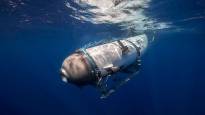If the submarine Titan that disappeared on Sunday is lying at the bottom of the sea and its five passengers are alive, they must be in trouble.
The seven-meter vessel, intended for a maximum of five people, is cramped. If the electricity has been cut off, it is dark inside and the coldness of about four degrees at the bottom of the sea quickly penetrates the interior.
– Just like if a car stops on the side of the road in winter, it won’t be long before it’s as cold inside the car as it is outside, states the head teacher of Merisotaop Iiro Penttilä From the National Defense University.
The rescuers have time to find the passengers alive for an estimated maximum of three days: on Monday, it was estimated that the ship will have enough oxygen for 70-96 hours.
So far, however, it is not even known what happened to the ship, let alone where it is.
“The worst thing would be an explosion inside the ship”
Penttilä finds it worrying that the connection with Titan has been completely broken. According to him, this is exceptional in submarine accidents.
A power outage would explain the disconnection. An electrical fault could cause the ship’s equipment to stop working.
– Normally, electrical devices are certified by several systems, but it is possible that something like that has happened, Penttilä tells by phone.
According to Penttilä, the worst option would be if an explosion occurred inside the ship.
– The pressure hull of the submarine is made to withstand external pressure, up to a depth of 4,000 meters in Titan. But it cannot withstand any internal pressure. That is, if, for example, the battery explodes due to an electric spark or something else, the pressure increase inside may break the pressure housing.
At that time, the hull would brown in those depths and water would flood inside.
– The situation would surely be over quickly, Penttilä says.
One possibility is that the Titan is entangled with something. Fishing nets or ropes, for example, could also have been caught in the wreck of the Titanic – which Titan was on his way to see.
– But that does not necessarily explain why the ship has not been contacted from the surface.
The ship can float in the sea, flounder on the bottom or drift under the surface
Penttilä says that he got the impression from the media that if the submarine was on the surface, there would have been some kind of connection with it.
– Even if there is an electrical fault, I believe they have emergency signaling devices, emergency rockets or torches with them. Then the ship would have been able to give distress signals that would have been detected from the surface vessel. But of course it is possible that the ship has managed to rise to the surface and is drifting somewhere.
If this were the case, the passengers would have to get out onto the deck through a manually opened hatch.
But if the frame is damaged, the hatch may not open at all. There is also a danger that the sea is so rough that seawater gets in when opening the hatch and sinks the ship again.
The ship’s pressure hull would withstand sinking to the bottom if the impact is not very strong. Then the biggest problem would be oxygen sufficiency.
Even if the electricity is out, the ship can drift in the sea. The ship has compartments that can be filled with air, which makes the ship lighter and lifts it closer to the surface.
– The electric motor controls the direction rather than the depth. But if the damage has occurred in one of the compartments, the ship quickly becomes heavier and sinks to the bottom.
According to Penttilä, a possible power outage could also affect the sufficiency of oxygen.
– I don’t have exact information about the systems on this ship, but usually submarines have a system where carbon dioxide is filtered out of the air. If the system is not in operation and the oxygen supply is solely based on compressed air tanks, the oxygen may be sufficient for a shorter time.
– We are fighting against time here, if the ship has sunk and the passengers are still alive.
On the other hand, there is no threat of hypothermia at four degrees in that time, if the passengers have enough clothes. The high pressure of the seabed doesn’t affect either: inside the thick steel walls, the pressure in the ship is the same as in the chamber of the earth.
– The pressure is kept suitable with compressed air. The pressure is probably managed automatically, but it is also possible to keep it suitable manually.
Rescuers are challenged by time and equipment
According to Penttilä, the big challenge of search and rescue work is getting equipment suitable for the challenging conditions on time.
– When there is no connection to the ship and it is not even known where it is, it must be located. After that, there must be equipment that can be used to get to the site, so we are talking about unmanned drones at the very least.
With their help, if necessary, it is possible to help the miniature submarine, with which the submarine can be raised to the surface in time.
– Very specific equipment is needed and there is absolutely no time.
According to Penttilä, the easiest situation would be if the ship was stuck in a rope or net. Then the ship could be cut free by an unmanned underwater vehicle.
After that, the ship might even be able to rise to the surface itself. If it is inoperable, heavier equipment is needed to lift it from the bottom.
The rescue operation will probably continue until the Titan is found and lifted up, even if the hopes of finding the passengers alive fade away, Penttilä believes.
